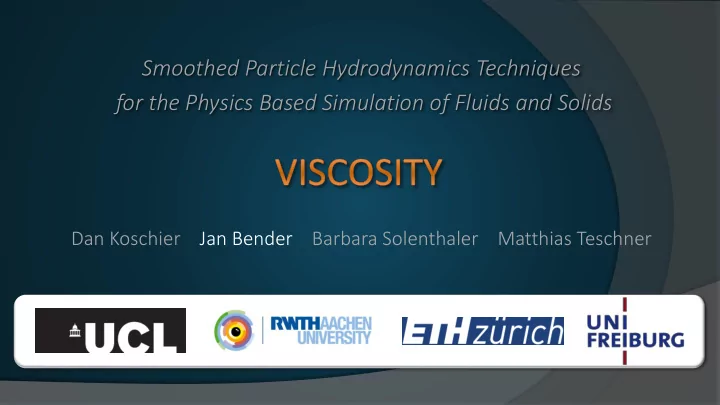

Smoothed Particle Hydrodynamics Techniques for the Physics Based Simulation of Fluids and Solids Dan Koschier Jan Bender Barbara Solenthaler Matthias Teschner
Motivation Viscous Force Explicit Viscosity Implicit Viscosity Results 1
2
Motivation Viscous Force Explicit Viscosity Implicit Viscosity Results 3
Lin inear momentum equatio ion: Newtonia ian constit itutiv ive model: Density Strain rate tensor Velocity Pressure Stress tensor Identity Force density Dynamic viscosity Navier-Stokes equations: 4
Viscous force for incompressible fluids: Recent SPH solvers either compute the divergence of the strain rate or directly determine the Laplacian of . Note that strain rate based approaches must enforce a divergence- free velocity field to avoid undesired bulk viscosity. 5
Motivation Viscous Force Explicit Viscosity Implicit Viscosity Results 6
Standard SPH discretization of this Laplacian: Disadvantages: Sensitive to particle disorder [Mon05, Pri12] The Laplacian of the kernel changes its sign inside the support radius 7
Alternative: determine one derivative using SPH and the second one using finite differences. Advantages: Galilean invariant vanishes for rigid body rotation conserves linear and angular momentum 8
Core idea of XSPH: reduce the particle disorder by smoothing the velocity field: XSPH can also be used as artificial viscosity model. Advantage: The second derivative is not needed. Disadvantage: is not physically meaningful. 9
Motivation Viscous Force Explicit Viscosity Implicit Viscosity Results 10
Compute the viscous force as divergence of the strain rate : Implicit integration scheme Solve linear system using the conjugate gradient method (CG). 11
Decompose velocity gradient: Reduce shear rate by user-defined factor : Reconstruct velocity field by solving linear system with CG: 12
Define velocity constraint for each particle with user-defined factor: The constraint is a 6D function due to the symmetric strain tensor. Solve linear system for corresponding Lagrange multipliers. 13
The introduced methods are based on the strain rate. However, computing the strain rate using SPH leads to errors at the free surface due to particle deficiency. (SPH computation) 14
Implicit integration scheme Compute Laplacian as Solve linear system using a meshless conjugate gradient method. Laplacian approximation avoids problems at the free surface. 15
The strain rate based formulation leads to errors and artifacts at the free surface, which is avoided by Weiler et al. The viscosity parameters of Bender and Peer depend on the temporal and spatial resolution. Peer’s reconstruction of the velocity field is fast but introduces a significant damping => not suitable for low viscous flow Takahashi et al. require the second-ring neighbors => low performance 16
Motivation Viscous Force Explicit Viscosity Implicit Viscosity Results 17
18
19
20
Low viscous flow Explicit methods are cheap and well-suited Approximation of Laplacian yields better results while XSPH is slightly faster Highly viscous fluids Implicit methods are recommended to guarantee stability Strain rate based SPH formulations lead to artifacts at the free surface Weiler et al. avoid this problem and generate more realistic results. 21
Recommend
More recommend